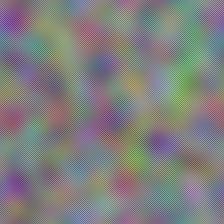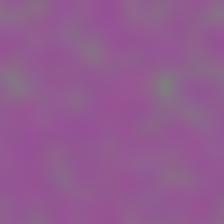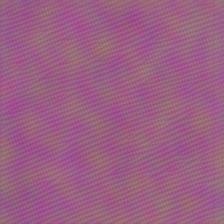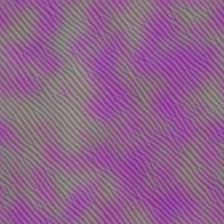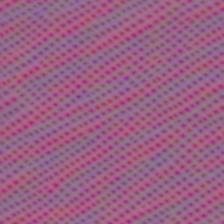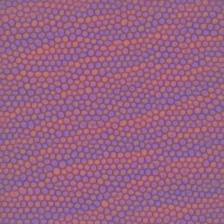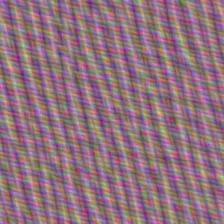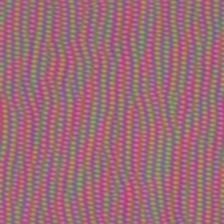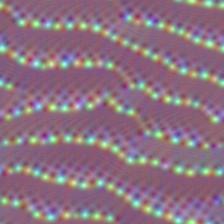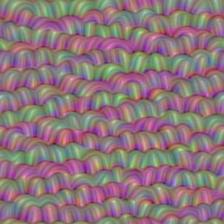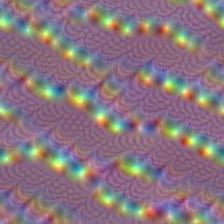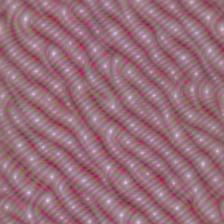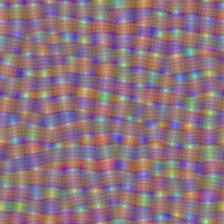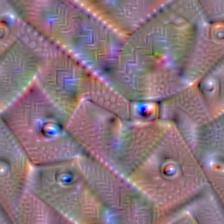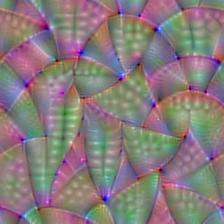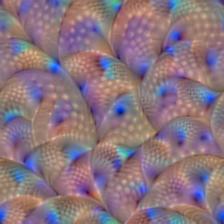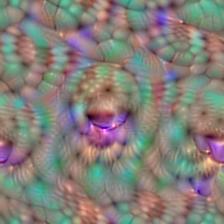What do ConvNets see? Visualizing filters with Activation Maximization
December 3, 2019 by Chris
Training a ConvNet can be equal to training a black box: you start the training process, get a model that performs (or not) and that's it. It's then up to you to find out what is possibly wrong, and whether it can be improved any further. This is difficult, since you cannot look inside the black box.
Or can you? In the past few years, many techniques have emerged that allow you to take a look inside that black box!
In this blog post, we'll cover Activation Maximization. It can be used to generate a 'perfect representation' for some aspect of your model - and in this case, convolutional filters. We provide an example implementation with keras-vis for visualizing your Keras CNNs, and show our results based on the VGG16 model.
All right - let's go! 😎
Recap: what are convolutional filters?
I find them interesting, these convolutional neural networks - you feed them image-like data, they start learning, and you may end up with a model that can correctly identify objects within real images, or classify the real images as a whole.
However, it's important to understand how convolutional neural networks work if we wish to understand how we can visualize their filters with Activation Maximization (which we will also cover next).
If you wish to understand convolutional neural networks in more detail, I would like to recommend you read these two blogs:
- Convolutional Neural Networks and their components for computer vision
- Understanding separable convolutions
However, if you already have a slight understanding about them or only need to reiterate your existing knowledge, hang on tight - as we'll give you a crash course ConvNets here.
Recall that this is the generic structure of a ConvNet:

The input might be a W x H RGB image, meaning that the input to the ConvNet is three-dimensional: the width, the height and the red, blue and green channels.
Once the data is input, it passes through N kernels (where N is an integer number, such as 3) or filters that have the same dimension. These kernels slide over the input data, performing element-wise multiplications, generating N feature maps of width Wfm and height Hfm, depending on the size of the kernel.
This convolutional operation is often followed by pooling operations, possibly by other convolutional operations, and likely, finally, by densely-connected neural operations, to generate a prediction. It is hence part of the high-level supervised learning process.
This also sheds light on how ConvNets actually learn. We saw that for any input, the kernels help determine the feature map. The kernels thus contain the patterns that the model has learnt. As after training the kernels are kept constant, they drive the predictions for all the inputs when a model is put into production (possibly augmented with the weights from the densely-connected layers - it's important to know that convolutions and Dense layers are often combined in ConvNets.)
But how does it learn? And what does it learn? Even though it might sound difficult, it's actually pretty simple. We know that the kernels contain the learnt information. They thus need to be adapted when learning needs to take place. From the high-level supervised learning process, the concept of a loss function, and the concept of an optimizer, we know that:
- Data is fed forward in full batches, minibatches or a stochastic (single-item) fashion.
- For every sample, a prediction is generated.
- The average difference between the predictions and the true targets (which are known in supervised settings) determines how bad the model performs, or - in other words - how high its loss is. How this is computed is determined by the choice of loss function.
- With backpropagation, the error displayed by the loss can be computed backwards to each neuron, computing what is known as a gradient, or the change of loss with respect to changes in neurons.
- With the optimizer, the (negative of the) computed gradient is applied to the neuron's weights, changing them and likely improving the model as a result. The choice of optimizer (such as gradient descent or adaptive optimizers) determines how gradients are applied.
Kernels are nothing but neurons structured differently. Hence, learning can take place by shifting neuron weights, which means that the high-level supervised learning process is responsible for changing the neurons. Recall that kernels are also called filters every now and then. With that in mind, let's now take a look at the concept of Activation Maximization - which we can use to visualize these filters.
Recap: what is Activation Maximization?
In different blog post, we used Activation Maximization to visualize the perfect input to produce some class prediction. This is a really powerful idea: we derive whether the model has learnt correctly by generating some input that maximizes activations in order to produce some output, which we set in advance - to some class that we wish to check. Really nice results!
But how does Activation Maximization work? The principle is simple:
- You keep the output class constant, you keep the weights constant, and change the input to find maximum activations for the constant class.
- If the generated input, which is the 'perfect input for some class' given the trained model, looks accurate, then you can be more confident that the model has learnt correctly.
- If it doesn't, you might wish to inspect learning in more detail with e.g. TensorBoard, saliency maps or Grad-CAMs, to identify where the model attends and which layers contribute to learning.
- You might do the same with Keract output visualizations, or read on, to learn how to visualize ConvNet filters with Activation Maximization.
Introducing keras-vis
Today, we'll be creating ConvNet filter visualizations with Keras, the deep learning framework that is deeply integrated with TensorFlow and originally created by François Chollet. We're going to use keras-vis for this purpose, which is a third-party toolkit for visualizing Keras models, supporting Activation Maximization, Saliency Maps and Grad-CAM class activation maps.
Or, in their words:
keras-vis is a high-level toolkit for visualizing and debugging your trained keras neural net models.
We will use it to visualize what a Keras based ConvNet sees through (some of its) filters, by means of Activation Maximization.
Installing keras-vis
The first step is installing keras-vis. Unfortunately, it is a little bit less straight-forward than performing a pip install keras-vis. That is due to the status of the pip package: it's not up to date, and hence doesn't run with newer Keras versions.
Fortunately, there is an escape.
It's actually rather simple, too: first, open up a terminal, preferably the terminal where you have access to all the other dependencies (Python, Keras, and so on). Second, run this command:
pip install https://github.com/raghakot/keras-vis/archive/master.zip
It still uses pip to install keras-vis, but simply installs the most recent version from the Github repository.
When you see this (or anything more recent than 0.5.0, you've successfully installed keras-vis:
>pip install https://github.com/raghakot/keras-vis/archive/master.zip
Collecting https://github.com/raghakot/keras-vis/archive/master.zip
Downloading https://github.com/raghakot/keras-vis/archive/master.zip
\ 58.1MB 819kB/s
Building wheels for collected packages: keras-vis
Building wheel for keras-vis (setup.py) ... done
Successfully built keras-vis
Installing collected packages: keras-vis
Successfully installed keras-vis-0.5.0
Today's model: VGG16
Now, let's take a look at today's model. Contrary to other posts, where we used a simple Convolutional Neural Network for visualization purposes (e.g. in our other Activation Maximization post), we don't use simple ones here today. This is due to the nature of this post: we're interested in generating filter visualizations that are relatively discriminative in terms of abstractness, yet show enough similarity to the task that we can include them here.
Fortunately, the Keras framework comes to the rescue; more specifically, the keras.applications (Github here). It is delivered with various model architectures included. That's perfect for our task today! 🎉
We're using the VGG16 model today. This model, which was created by scientists at the Visual Geometry Group (hence VGG) at the University of Oxford, participated in the ImageNet Large Scale Visual Recognition Challenge of 2014. It uses many (sixteen, in our case - hence VGG16) convolutional layers and has achieved substantial accuracies in the 2014 competition. If you wish to read more about VGG16, click here for an excellent resource.
ConvNets can be trained on any dataset. However, what often happens is that large-scale datasets are used for pretraining, only to be slightly altered by subsequent training afterwards, possibly for another purpose - a process called Transfer Learning. These large-scale datasets therefore come delivered with such models often, and in this case it's the same. The Keras VGG16 model can be used directly while it is initialized with weights trained on the ImageNet dataset, if you wish. Today, we'll do precisely that: visualizing filters of the VGG16 model when it's initialized on the ImageNet dataset.
Let's go! 😀
Creating ConvNet filter visualizations
What you'll need to run this code
As usual, you'll to install a set of dependencies if you wish to run the model & the visualization code:
- Python, as we will create Python code. Preferably, use version 3.6+. I can't guarantee that it works with older versions.
- Keras, which is the deep learning framework that we will use today.
- One of the Keras backends - being Tensorflow, Theano and CNTK - and of these, preferably Tensorflow.
- Keras-vis, which you can install by following the instructions above.
- Matplotlib, for saving the visualizations to disk as images.
- Numpy, for number processing.
Imports & VGG16 initialization
Now, let's write some code! 😎
To start, create a file in some directory, e.g. activation_maximization_filters.py.
Open this file in the code editor of your choice, and write with me:
'''
ConvNet filter visualization with Activation Maximization on exemplary VGG16 Keras model
'''
from keras.applications import VGG16
from vis.utils import utils
from vis.visualization import visualize_activation, get_num_filters
from vis.input_modifiers import Jitter
import matplotlib.pyplot as plt
import numpy as np
import random
import os.path
These are the imports that you'll need for today's tutorial:
- You import
VGG16fromkeras.applications, which is the model that we're using today. - From
keras-vis, you'll importutils(for finding the layer index of the to be visualized layer later),visualize_activationandget_num_filters(for the visualization part) andJitter(to boost image quality). - You'll import the PyPlot API from Matplotlib into
plt. - Numpy is imported for number processing,
randomis used for drawing a random sample, andos.pathfor selecting the path to write the images to.
Now, let's define the name of the folder which we'll be writing into:
# Define the folder name to save into
folder_name = 'filter_visualizations'
Then define the model:
# Define the model
model = VGG16(weights='imagenet', include_top=True)
This initializes the VGG16 model into the model variable, and initializes it with weights trained on the ImageNet dataset. With include_top, the densely-connected layers that generate the prediction are included; if set to False, you'll only get the convolutional layers. The latter is especially useful when you wish to use pretrained Keras models as your convolutional base, to train additional layers further.
Generating visualizations
Next, we can generate some visualizations!
# Iterate over multiple layers
for layer_nm in ['block1_conv1', 'block2_conv1', 'block3_conv2', 'block4_conv1', 'block5_conv2']:
This part means that your code will iterate over an array that contains various layers:
- The first Conv layer of the first Conv block;
- The first Conv layer of the second Conv block;
- The second Conv layer of the third Conv block;
- The first Conv layer of the fourth Conv block;
- The second Conv layer of the fifth Conv block.
That is, it will generate visualizations for (a random selection of) the filters that are part of these blocks. In your case, you may choose any blocks. This, however, comes in to flavors. When using Keras pretrained models, you can look for the layer names in the code available for these models - such as for the VGG16 at Keras' GitHub (search for 'block1_conv1' on this page, to give you an example). When you do however visualize the Conv filters of your own models, you'll have to name layers yourself when you stack the architecture:
model.add(Dense(no_classes, activation='softmax', name='dense_layer'))
When adding these names to the array above, you'll ensure that you're visualizing the correct layers.
The following code is part of the iteration, which means that it runs every time the loop is activated (in our case, five times, for five layers):
# Find the particular layer
layer_idx = utils.find_layer_idx(model, layer_nm)
...this keras-vis util finds the correct layer index for the name that we specify. layer_nm, in this case, is one of the layer names in the array, e.g. block1_conv1.
# Get the number of filters in this layer
num_filters = get_num_filters(model.layers[layer_idx])
We then retrieve the number of filters in this layer. This is also done by applying a nice Keras-vis util.
Then, we select six filters randomly (with replacement, so there's a small chance that you visualize one or two filters twice - but I've found that this doesn't really happen given the large number of filters present in VGG16. For your own model, this may be different):
# Draw 6 filters randomly
drawn_filters = random.choices(np.arange(num_filters), k=6)
Finally, we visualize each filter drawn:
# Visualize each filter
for filter_id in drawn_filters:
img = visualize_activation(model, layer_idx, filter_indices=filter_id, input_modifiers=[Jitter(16)])
plt.imshow(img)
img_path = os.path.join('.', folder_name, layer_nm + '_' + str(filter_id) + '.jpg')
plt.imsave(img_path, img)
print(f'Saved layer {layer_nm}/{filter_id} to file!')
- We iterate over every filter.
- We visualize its activation with
keras_vis, for the particularfilter_id, modifying the input withJitterto make the images more clear. - Subsequently, we draw the array (which is returned by
keras-vis) with Matplotlib. - We don't show the visualization on screen, but rather save them to
img_path(based on thefolder_name,layer_nmandfilter_idproperties) with Matplotlib. - Finally, we print that the layer was visualized and that the visualization was saved - allowing you to take a look at what was generated!
Results
In my case, these were the results:
Block1Conv1
For the first Conv layer in the first Conv block, the results are not very detailed. However, filters clearly distinguish from each other, as can be seen from the results:
Block2Conv1
In the second block, a little bit more detail becomes visible. Certain stretched patterns seem to be learnt by the filters.
Block3Conv2
This gets even clearer in the third block. The stretches are now combined with clear patterns, and even blocky representations, like in the center-bottom visualization.
Block4Conv1
Details become visible in the fourth convolutional block. It's still difficult to identify real objects in these visualizations, though.
Block5Conv2
This latter becomes possible in the visualizations generated from the fifth block. We see eyes and other shapes, which clearly resemble the objects that this model was trained to identify.
This clearly illustrates that the model learns very detailed patterns near the output, i.e. in the final layers of the model, whereas more global and abstract ones are learnt in the early layers. It now makes perfect sense why the first two or perhaps three layers of ImageNet trained models are often used in practical settings in order to boost training accuracy: the patterns that are learnt are so general that they do not necessarily represent the object in question, but rather the shape in question. While both the sun, a football and a volleyball are round, we don't know whether an input is any of those in the first few layers. We do know, however, that it's round.
Summary
In this blog post, we've seen how we can use Activation Maximization to generate visualizations for filters in our CNNs, i.e. convolutional neural networks. We provided an example that demonstrates this by means of the keras-vis toolkit, which can be used to visualize Keras models.
I hope you've learnt something today! 😀 If you did, or if you have any questions or remarks, please feel free to leave a comment in the comments box below 👇 Thank you for reading MachineCurve today and happy engineering! 😎
References
Kotikalapudi, Raghavendra and contributors. (2017). Github / keras-vis. Retrieved from https://github.com/raghakot/keras-vis
Simonyan, K., & Zisserman, A. (2014). Very deep convolutional networks for large-scale image recognition. arXiv preprint arXiv:1409.1556.
VGG16 - Convolutional Network for Classification and Detection. (2018, November 21). Retrieved from https://neurohive.io/en/popular-networks/vgg16/

Hi, I'm Chris!
I know a thing or two about AI and machine learning. Welcome to MachineCurve.com, where machine learning is explained in gentle terms.
Getting started
Foundation models
Learn how large language models and other foundation models are working and how you can train open source ones yourself.
Keras
Keras is a high-level API for TensorFlow. It is one of the most popular deep learning frameworks.
Machine learning theory
Read about the fundamentals of machine learning, deep learning and artificial intelligence.
Most recent articles
January 2, 2024
What is Retrieval-Augmented Generation?
December 27, 2023
In-Context Learning: what it is and how it works
December 22, 2023
CLIP: how it works, how it's trained and how to use it
Article tags
Most popular articles
February 18, 2020
How to use K-fold Cross Validation with TensorFlow 2 and Keras?
December 28, 2020
Introduction to Transformers in Machine Learning
December 27, 2021
StyleGAN, a step-by-step introduction
July 17, 2019
This Person Does Not Exist - how does it work?
October 26, 2020
Your First Machine Learning Project with TensorFlow 2.0 and Keras
Connect on social media
Connect with me on LinkedIn
To get in touch with me, please connect with me on LinkedIn. Make sure to write me a message saying hi!
Side info
The content on this website is written for educational purposes. In writing the articles, I have attempted to be as correct and precise as possible. Should you find any errors, please let me know by creating an issue or pull request in this GitHub repository.
All text on this website written by me is copyrighted and may not be used without prior permission. Creating citations using content from this website is allowed if a reference is added, including an URL reference to the referenced article.
If you have any questions or remarks, feel free to get in touch.
TensorFlow, the TensorFlow logo and any related marks are trademarks of Google Inc.
PyTorch, the PyTorch logo and any related marks are trademarks of The Linux Foundation.
Montserrat and Source Sans are fonts licensed under the SIL Open Font License version 1.1.
Mathjax is licensed under the Apache License, Version 2.0.

